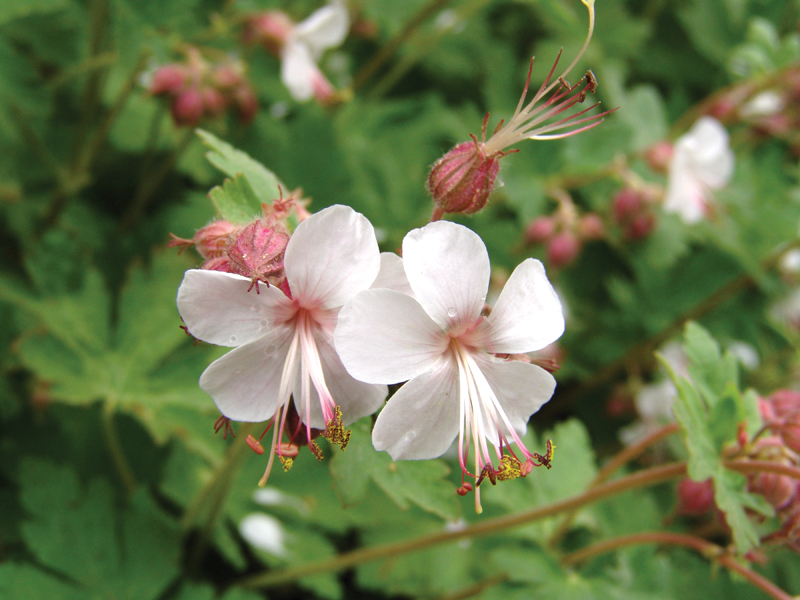
Perennial Solutions: Geranium x cantabrigiense ‘Biokova’
Although not a recent introduction, Geranium x cantabrigiense ‘Biokova’ has proven itself as a reliable perennial over the past couple of decades. Case in point, the members of the Perennial Plant Association (www.perennialplant.org) have selected ‘Biokova’ as the its 2015 Perennial Plant of the Year.
‘Biokova’ is a low-growing geranium, forming dense mounds reaching a manageable 6 to 8 inches tall and spreading to 18 inches across. The glossy green palmate foliage is covered with masses of dainty white flowers with light pink veins and stamens for several weeks of enjoyment in the late spring. After the initial flush, it blooms again sporadically throughout the summer months; a light trim after flowering will freshen the foliage and promote additional flowering. As an added bonus, ‘Biokova’ provides seasonal interest as the semi-evergreen leaves turn red in the autumn.
Geranium x cantabrigiense ‘Biokova’ is a naturally occurring interspecific hybrid of two geranium species: G. macrorrhizum and G. dalmaticum. ‘Biokova’ was discovered by the German plantsman, Dr. Hans Simon in the Biokova Mountains in the former Yugoslavia. This great, low growing hardy geranium performs well in locations with partial to full sun throughout USDA Hardiness Zones 4 to 8.
Although ‘Biokova’ provides a delicate texture to the landscape, don’t be mistaken, it is a durable, low maintenance perennial. This is a great plant for attracting butterflies into the landscape; while deer tend to avoid it, opting for tastier treats elsewhere. Consider using ‘Biokova’ in mass plantings or as a perennial border or container plant.
Propagation
‘Biokova’ is vegetatively propagated from tip cuttings. Choose a propagation mix with good drainage and good aeration porosity. Moisten the rooting substrate prior to sticking the unrooted cuttings (URCs). Rooting compounds are beneficial; spraying the cuttings with 1,000-ppm IBA soluble salts within 24 hours of sticking will improve the uniformity of rooting and decrease rooting times.
Place the geranium cuttings under a moderate misting regime for the first two to three days of propagation. Then provide a low misting regiment for the next seven to ten days. Avoid over misting as this will saturate the propagation mix and result in slower rooting and other cultural problems. Maintain high humidity levels (90 percent relative humidity) and gradually decrease the misting throughout the remainder of propagation. Apply 100-ppm nitrogen beginning five to seven days after sticking the cuttings. With soil temperatures being maintained at 68 to 75° F they will usually be well rooted in two to three weeks. Liners take approximately five to six weeks from sticking to become fully rooted and ready for shipping or potting.
Production
‘Biokova’ is suitable for production in 1.5-quart to 1-gallon containers. Geraniums perform best when they are grown in a moist, well drained growing mix. Transplant one liner per container; the top of the starter plug should be even with the soil line of the finished container. Planting them too deeply often results in reduced vigor and increases the incidence of crown rots.
Geraniums are light to moderate feeders. Growers can deliver nutrients using water-soluble fertilizers with each irrigation applying 75 to 100 ppm or using 150 to 200 ppm every other irrigation. Nutrients can also be delivered using controlled release fertilizers by topdressing with the medium recommended rate on the fertilizer label or incorporating into the growing mix prior to planting using a rate equivalent to 0.9 to 1.2 pounds of elemental nitrogen per yard of growing mix. Providing excessive nutrients will lead to softer growth and may delay flowering.
Hybrid cranesbill requires average amounts of irrigation; they should be kept at moderate to moist moisture levels during production. Water thoroughly when irrigation is necessary and allow them to dry slightly between waterings.
For plant establishment, I find it beneficial to maintain average temperatures of at least 65° F. Once they are established, grow geraniums with 55 to 70° F day temperatures, and night temperatures between 55 to 60° F. The best quality plants are produced under moderate light levels (minimum of 4,000 foot-candles).
With the naturally compact growing habit of ‘Biokova’, it is usually not necessary to implement height management strategies. Undesirable stem elongation can often be managed by providing adequate spacing between the plants, avoiding excessive fertilization and growing them under high light levels. If the plants need to be toned, apply spray applications of 5-ppm uniconazole or tank mixing 2,000-ppm daminozide plus 3-ppm uniconazole. In most instances, one or two application will be sufficient.
Insects and Diseases
A few insects and diseases may be observed on hardy geraniums during production. The most common insect pests are aphids, caterpillars, fungus gnats (mostly in propagation), thrips and whiteflies. Botrytis, fungal leaf spots (Alternaria, Phlyllosticta and Cercospora), bacterial leaf spots (Xanthomonas), downy mildew, powdery mildew and crown rots are the most common diseases observed on cranesbill. Growers should utilize routine scouting programs to detect the presence of insects and diseases early and to determine if and when control measures are necessary. In addition to monitoring the crops regularly, the incidence of foliar diseases can be reduced by growing the plants at an adequate spacing, providing good air circulation and watering early in the day to allow the foliage time to dry.
Temperature and Scheduling
Geranium ‘Biokova’ is easy to grow; blooming plants can be produced throughout the growing season by following a few guidelines. ‘Biokova’ does not require cold for flowering and flower best when they are grown under long days (>14 hours).
For early spring sales, it is best to plant them in the fall, bulk them up and overwinter them prior to spring forcing. If the plants need additional bulking in the spring grow them under natural day lengths; once they have sized up, provide photoperiodic (day extension or night interruption) lighting. After the onset of long days the plants will flower in four to five weeks when they are grown at 65 to 68° F.
Availability
Geranium x cantabrigiense ‘Biokova’ is widely available and propagated by a number of reputable propagators. Most plant brokers should be able to help you source this variety.


 Video Library
Video Library 



















